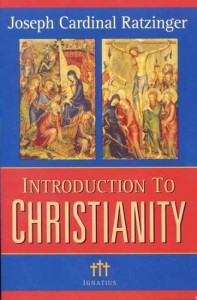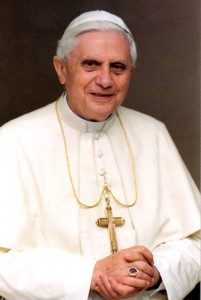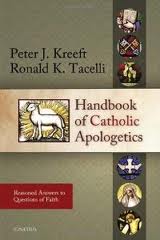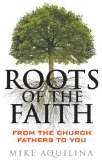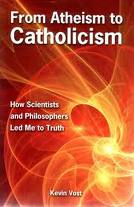“Why is this granted me, that the mother of my Lord should come to me?”
[powerpress feed=”daily-scripture”]
an excerpt from today’s reflection by Don Schwager:
Do you recognize the indwelling presence of the Lord Jesus in your life? Blessed are you if you see and recognize the Lord with the “eyes of faith”. The word “blessed” [makarios in Greek] literally means “happiness” or “beatitude”. It describes a kind of joy which is serene and untouchable, self-contained, and independent from chance and changing circumstances of life. There is a certain paradox for those “blessed” by the Lord. Mary was given the “blessedness” of being the mother of the Son of God. That blessedness also would become a sword which pierced her heart as her Son died upon the cross. Anselm, a great teacher and Archbishop of Canterberry (1033-1109), spoke these words in a homily: “Without God’s Son nothing could exist; without Mary’s son, nothing could be redeemed.” To be chosen by God is an awesome privilege and responsibility. Mary received both a crown of joy and a cross of sorrow. Her joy was not diminished by her sorrow because it 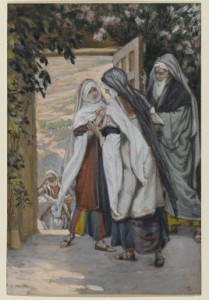 was fueled by her faith, hope, and trust in God and his promises. Jesus promised his disciples that “no one will take your joy from you” (John 16:22). The Lord gives us a supernatural joy which enables us to bear any sorrow or pain and which neither life nor death can take away. Do you know the joy of a life given over to God in faith and trust?
was fueled by her faith, hope, and trust in God and his promises. Jesus promised his disciples that “no one will take your joy from you” (John 16:22). The Lord gives us a supernatural joy which enables us to bear any sorrow or pain and which neither life nor death can take away. Do you know the joy of a life given over to God in faith and trust?
What is the significance of Mary’s visit to her cousin Elizabeth before the birth of Jesus? When Elizabeth greeted Mary and recognized the Messiah in Mary’s womb they were filled with the Holy Spirit and with a joyful anticipation of the fulfilment of God’s promise to give a Savior. What a marvelous wonder for God to fill not only Elizabeth’s heart with his Holy Spirit but the child in her womb as well. John the Baptist, even before the birth of the Messiah, pointed to his coming and leapt for joy in the womb of his mother as the Holy Spirit revealed to him the presence of the King to be born. The Holy Spirit is God’s gift to us to enable us to know and experience the indwelling presence of God and the power of his kingdom. The Holy Spirit is the way in which God reigns within each of us. Do you live in the joy and knowledge of God’s indwelling presence with you through his Holy Spirit?
“Lord Jesus, fill me with your Holy Spirit and give me joy in seeking you more closely. Increase my faith in all your promises, my hope in the joys of heaven, and my love for You as my All.”
for the full reflection visit : Daily Reading and Meditation
Tags: catholic, catholic podcast, catholic prayer, cathollc spirituality, don schwager, faith, gospel of luke, holy spirit, joy, mother
This entry was posted on Tuesday, May 31st, 2011 at 12:29 am
You can follow any responses to this entry through the RSS 2.0 feed.
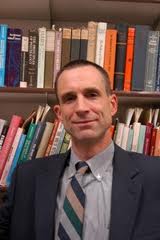 Episode 2- What is the relationship between religion and science?
Episode 2- What is the relationship between religion and science?
[powerpress]
 Question 1 Article 2. Whether sacred doctrine is a science.
Question 1 Article 2. Whether sacred doctrine is a science.
Objection 1: It seems that sacred doctrine is not a science. For every science proceeds from self-evident principles. But sacred doctrine proceeds from articles of faith which are not self-evident, since their truth is not admitted by all: “For all men have not faith” (2 Thess. 3:2). Therefore sacred doctrine is not a science.
Objection 2: Further, no science deals with individual facts. But this sacred science treats of individual facts, such as the deeds of Abraham, Isaac and Jacob and such like. Therefore sacred doctrine is not a science.
On the contrary, Augustine says (De Trin. xiv, 1) “to this science alone belongs that whereby saving faith is begotten, nourished, protected and strengthened.” But this can be said of no science except sacred doctrine. Therefore sacred doctrine is a science.
I answer that, Sacred doctrine is a science. We must bear in mind that there are two kinds of sciences. There are some which proceed from a principle known by the natural light of intelligence, such as arithmetic and geometry and the like. There are some which proceed from principles known by the light of a higher science: thus the science of perspective proceeds from principles established by geometry, and music from principles established by arithmetic. So it is that sacred doctrine is a science because it proceeds from principles established by the light of a higher science, namely, the science of God and the blessed. Hence, just as the musician accepts on authority the principles taught him by the mathematician, so sacred science is established on principles revealed by God.
Reply to Objection 1: The principles of any science are either in themselves self-evident, or reducible to the conclusions of a higher science; and such, as we have said, are the principles of sacred doctrine.
Reply to Objection 2: Individual facts are treated of in sacred doctrine, not because it is concerned with them principally, but they are introduced rather both as examples to be followed in our lives (as in moral sciences) and in order to establish the authority of those men through whom the divine revelation, on which this sacred scripture or doctrine is based, has come down to us.
For an online version of St. Thomas Aquinas’ “Summa” click here
“Christian Apologetics with Dr. R. R. Reno” explores numerous facets of faith and reason in the life of the Church and the world. Grounded on the work of giants, such as St. Thomas Aquinas, St. Bonaventure, Blessed John Newman, soon-to-be Blessed John Paul II, G. K. Chesterton, Blaise Pascal and Stephen Barr, Dr. Reno helps us to open our minds to make the journey to our hearts.
R. R. Reno is the editor at First Things: A Journal of Religion, Culture, and Public Life, and Professor of Theology, currently on leave from Creighton University. His theological work has been published in many academic journals. Essays and opinion pieces on religion, public life, contemporary culture, and current events have appeared in Commentary, and the Washington Post. In Fighting the Noonday Devil Reno suggests that putting ourselves at the disposal of what is real is what trains us for true piety. His other recent books include Genesis: Brazos Theological Commentary on the Bible and Sanctified Vision: An Introduction to Early Christian Interpretation of the Bible.
Tags: catholic, catholic podcast, catholic prayer, cathollc spirituality, christian apologetics, creighton university, faith, first things, r r reno, relationship, religion, science, st thomas aquinas, summa theologica
This entry was posted on Monday, May 23rd, 2011 at 12:11 am
You can follow any responses to this entry through the RSS 2.0 feed.
 Episode 1 – What is Christian Apologetics? Who was St. Thomas Aquinas, his life, his times, and his contribution. What is “theology”? What is the “Summa”?
Episode 1 – What is Christian Apologetics? Who was St. Thomas Aquinas, his life, his times, and his contribution. What is “theology”? What is the “Summa”?
[powerpress]
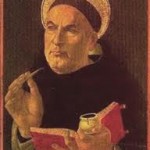 Question 1. article 1Â The nature and extent of sacred doctrine
Question 1. article 1Â The nature and extent of sacred doctrine
Whether, besides philosophy, any further doctrine is required?
Objection 1: It seems that, besides philosophical science, we have no need of any further knowledge. For man should not seek to know what is above reason: “Seek not the things that are too high for thee” (Ecclus. 3:22). But whatever is not above reason is fully treated of in philosophical science. Therefore any other knowledge besides philosophical science is superfluous.
Objection 2: Further, knowledge can be concerned only with being, for nothing can be known, save what is true; and all that is, is true. But everything that is, is treated of in philosophical science—even God Himself; so that there is a part of philosophy called theology, or the divine science, as Aristotle has proved (Metaph. vi). Therefore, besides philosophical science, there is no need of any further knowledge.
On the contrary, It is written (2 Tim. 3:16): “All Scripture, inspired of God is profitable to teach, to reprove, to correct, to instruct in justice.” Now Scripture, inspired of God, is no part of philosophical science, which has been built up by human reason. Therefore it is useful that besides philosophical science, there should be other knowledge, i.e. inspired of God.
I answer that, It was necessary for man’s salvation that there should be a knowledge revealed by God besides philosophical science built up by human reason. Firstly, indeed, because man is directed to God, as to an end that surpasses the grasp of his reason: “The eye hath not seen, O God, besides Thee, what things Thou hast prepared for them that wait for Thee” (Is. 66:4). But the end must first be known by men who are to direct their thoughts and actions to the end. Hence it was necessary for the salvation of man that certain truths which exceed human reason should be made known to him by divine revelation. Even as regards those truths about God which human reason could have discovered, it was necessary that man should be taught by a divine revelation; because the truth about God such as reason could discover, would only be known by a few, and that after a long time, and with the admixture of many errors. Whereas man’s whole salvation, which is in God, depends upon the knowledge of this truth. Therefore, in order that the salvation of men might be brought about more fitly and more surely, it was necessary that they should be taught divine truths by divine revelation. It was therefore necessary that besides philosophical science built up by reason, there should be a sacred science learned through revelation.
Reply to Objection 1: Although those things which are beyond man’s knowledge may not be sought for by man through his reason, nevertheless, once they are revealed by God, they must be accepted by faith. Hence the sacred text continues, “For many things are shown to thee above the understanding of man” (Ecclus. 3:25). And in this, the sacred science consists.
Reply to Objection 2: Sciences are differentiated according to the various means through which knowledge is obtained. For the astronomer and the physicist both may prove the same conclusion: that the earth, for instance, is round: the astronomer by means of mathematics (i.e. abstracting from matter), but the physicist by means of matter itself. Hence there is no reason why those things which may be learned from philosophical science, so far as they can be known by natural reason, may not also be taught us by another science so far as they fall within revelation. Hence theology included in sacred doctrine differs in kind from that theology which is part of philosophy.
For an online version of St. Thomas Aquinas’ “Summa” click here
“Christian Apologetics with Dr. R. R. Reno” explores numerous facets of faith and reason in the life of the Church and the world. Grounded on the work of giants, such as St. Thomas Aquinas, St. Bonaventure, Blessed John Newman, soon-to-be Blessed John Paul II, G. K. Chesterton, Blaise Paschal and Stephen Barr, Dr. Reno helps us to open our minds to make the journey to our hearts.
R. R. Reno is the editor at First Things: A Journal of Religion, Culture, and Public Life, and Professor of Theology, currently on leave from Creighton University. His theological work has been published in many academic journals. Essays and opinion pieces on religion, public life, contemporary culture, and current events have appeared in Commentary, and the Washington Post. In Fighting the Noonday Devil Reno suggests that putting ourselves at the disposal of what is real is what trains us for true piety. His other recent books include Genesis: Brazos Theological Commentary on the Bible and Sanctified Vision: An Introduction to Early Christian Interpretation of the Bible.
Tags: Blessed John Newman, catholic, catholic podcast, catholic prayer, cathollc spirituality, creighton university, faith, first things, r r reno, summa theologica, thomas aquinas, work
This entry was posted on Wednesday, May 4th, 2011 at 8:25 am
You can follow any responses to this entry through the RSS 2.0 feed.
“Introduction to Christianity” by Cardinal Joseph Ratizinger (Pope Benedict XVI) is a modern day classic! Fr. Joseph Fessio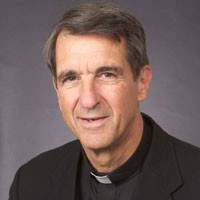 S.J., founder of Ignatius Press and student of Pope Benedict, joins us to break open the gift of insight and wisdom contained in this inspirational work of our Holy Father. As the Pope Benedict states in the preface in the 2nd edition of the book, that approach, taken in the book, puts the question of God and the question about Christ in the very center, which leads to a “narrative Christology” and demonstrates that the place for faith is in the Church. It is an excellent edition to all Christian libraries and a must for anyone seeking a richer appreciation of the teachings of faith. Pope Benedict uses the Old and New Testament, the teachings of the Fathers of the Church and generations of Saints, as well as the beauty of the Church’s Tradition to ponder the reality of Christ. It’s beautiful!
S.J., founder of Ignatius Press and student of Pope Benedict, joins us to break open the gift of insight and wisdom contained in this inspirational work of our Holy Father. As the Pope Benedict states in the preface in the 2nd edition of the book, that approach, taken in the book, puts the question of God and the question about Christ in the very center, which leads to a “narrative Christology” and demonstrates that the place for faith is in the Church. It is an excellent edition to all Christian libraries and a must for anyone seeking a richer appreciation of the teachings of faith. Pope Benedict uses the Old and New Testament, the teachings of the Fathers of the Church and generations of Saints, as well as the beauty of the Church’s Tradition to ponder the reality of Christ. It’s beautiful!
[powerpress]
For more information on this work as well as all the books by Joseph Cardinal Ratzinger (Pope Benedict XVI), go to www.ignatius.com
Tags: cardinal joseph ratizinger, catholic, catholic podcast, catholic prayer, cathollc spirituality, christian classic, Church, faith, ignatius press, introduction to christianity, joseph cardinal ratzinger, joseph fessio, pope benedict, pope benedict xvi, work
This entry was posted on Monday, April 4th, 2011 at 10:24 am
You can follow any responses to this entry through the RSS 2.0 feed.
Fr. Dwight Longenecker is Catholic priest and writer who has experienced an interesting journey of faith. Born into a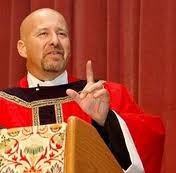 Evanglical Christian family in Pennsylvania, graduate from fundamentalist Bob Jones University in Florida, and he would later become an Anglican priest serving as a curate, a chaplain at Cambridge, and a country parson. Then, in 1995, he and his wife and family were received into the Roman Catholic Church. He spent the next ten years working as a freelance Catholic writer, contributing to over twenty-five magazines, papers and journals in Britain, Ireland and the USA.
Evanglical Christian family in Pennsylvania, graduate from fundamentalist Bob Jones University in Florida, and he would later become an Anglican priest serving as a curate, a chaplain at Cambridge, and a country parson. Then, in 1995, he and his wife and family were received into the Roman Catholic Church. He spent the next ten years working as a freelance Catholic writer, contributing to over twenty-five magazines, papers and journals in Britain, Ireland and the USA.
Fr. Longenecker has expanded and revised his book “More Christianity:  where he invites the readers to move from “Mere Christianity” to “More Christianity” in the Roman Catholic faith. Filled with every 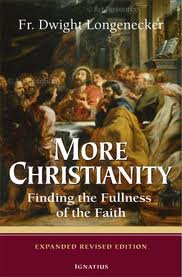 major aspect of our Catholic faith, Fr. Longenecker book serves, not only as resource to help Evangelicals to understand the Catholic faith, but also is excellent for Catholics who wish to deepen their own knowledge of the faith we profess.
major aspect of our Catholic faith, Fr. Longenecker book serves, not only as resource to help Evangelicals to understand the Catholic faith, but also is excellent for Catholics who wish to deepen their own knowledge of the faith we profess.
Visit Fr. Longenecker’s blog “Standing on My Head” to learn more about this and other books, as well as so much more
[powerpress]
Tags: catholic, catholic apologetics, catholic apologists, catholic podcast, catholic prayer, cathollc spirituality, Evanglical Christian, faith, ignatius press, roman catholic church, Visit Fr
This entry was posted on Monday, February 28th, 2011 at 2:53 pm
You can follow any responses to this entry through the RSS 2.0 feed.
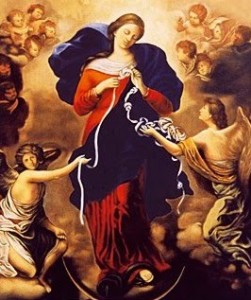 Click here for the complete text and audio for the Mary, Untier of Knots Novena
Click here for the complete text and audio for the Mary, Untier of Knots Novena
Sign of the Cross
Act of Contrition
Nineth day:
Bible reading:
« 14 All of these together gave themselves to constant prayer. With them were some women and also Mary, the mother of Jesus, and his brothers…» and »when the day of Pentecost arrived, all were filled with the Holy Spirit.» (Acts 1:14 and 2:1-4)
Brief Reflection:
Our Father sends the Holy Spirit on the feast of Pentecost , that will feed us in our faith. This is the same faith that with Mary’s maternal help, will remove the bonds that keep us prisoners. With the light of the Holy Spirit we see in meridian clarity which of our anguishes had our spirit trapped. The guidance of Saint Michael the Archangel has always been certain, Saint Gabriel the Archangel will announce my freedom and Saint Michael the Archangel, will protect me from any attack. The Evil one (the serpent), overpowered by the presence of Mary, lies at her feet, made into a useless knot, unable to touch us.
( Brief meditation: meditate with one decade of the Holy Rosary: One Our Father, 10 Hail Mary’s, One Glory be and the Prayer to “The Virgin Mary untier of Knotsâ€)
Tags: audio, blessed mother, catholic, catholic podcast, catholic prayer, cathollc spirituality, day of Pentecost, faith, freedom, holy spirit, mary undoer of knots, mary untier of knots, Saint Michael the Archangel, The Virgin Mary, virgin mary
This entry was posted on Saturday, January 8th, 2011 at 12:03 am
You can follow any responses to this entry through the RSS 2.0 feed.
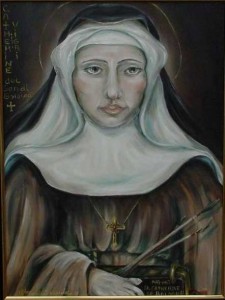 Patroness of Artists and Against Spiritual Temptation
Patroness of Artists and Against Spiritual Temptation
VATICAN CITY, 29 DEC 2010 (vatican.va) –
Dear Brothers and Sisters,
In a recent Catechesis I spoke of St Catherine of Siena. Today I would like to present to you another less well known Saint who has the same name: St Catherine of Bologna, a very erudite yet very humble woman. She was dedicated to prayer but was always ready to serve; generous in sacrifice but full of joy in welcoming Christ with the Cross. Catherine was born in Bologna on 8 September 1413, the eldest child of Benvenuta Mammolini and John de’ Vigri, a rich and cultured patrician of Ferrara, a doctor in law and a public lector in Padua, where he carried out diplomatic missions for Nicholas III d’Este, Marquis of Ferrara.
Not much information about Catherine’s infancy and childhood is available and not all of it is reliable. As a child she lived in her grandparents’ house in Bologna, where she was brought up by relatives, especially by her mother who was a woman of deep faith. With her, Catherine moved to Ferrara when she was about 10 years old and entered the court of Nicholas III d’Este as lady-in-waiting to Margaret, Nicholas’ illegitimate daughter. The Marquis was transforming Ferrara into a fine city, summoning artists and scholars from various countries. He encouraged culture and, although his private life was not exemplary, took great care of the spiritual good, moral conduct and education of his subjects. In Ferrara Catherine was unaware of the negative aspects that are often part and parcel of court life. She enjoyed Margaret’s friendship and became her confidante. She developed her culture by studying music, painting and dancing; she learned to write poetry and literary compositions and to play the viola; she became expert in the art of miniature-painting and copying; she perfected her knowledge of Latin. In her future monastic life she was to put to good use the cultural and artistic heritage she had acquired in these years. She learned with ease, enthusiasm and tenacity. She showed great prudence, as well as an unusual modesty, grace and kindness in her behaviour. However, one absolutely clear trait distinguished her: her spirit, constantly focused on the things of Heaven. In 1427, when she was only 14 years old and subsequent to certain family events, Catherine decided to leave the court to join a group of young noble women who lived a community life dedicating themselves to God. Her mother trustingly consented in spite of having other plans for her daughter. We know nothing of Catherine’s spiritual path prior to this decision. Speaking in the third person, she states that she entered God’s service, “illumined by divine grace… with an upright conscience and great fervourâ€, attentive to holy prayer by night and by day, striving to acquire all the virtues she saw in others, “not out of envy but the better to please God in whom she had placed all her love†(Le sette armi necessarie alla battaglia spirituali, [The seven spiritual weapons], VII, 8, Bologna 1998, p. 12). She made considerable spiritual progress in this new phase of her life but her trials, her inner suffering and especially the temptations of the devil were great and terrible. She passed through a profound spiritual crisis and came to the brink of despair (cf. ibid., VII, 2, pp. 12-29). She lived in the night of the spirit, and was also deeply shaken by the temptation of disbelief in the Eucharist.
After so much suffering, the Lord comforted her: he gave her, in a vision, a clear awareness of the Real Presence in the Eucharist, an awareness so dazzling that Catherine was unable to express it in words (cf. ibid., VIII, 2. pp. 42-46).
In this same period a sorrowful trial afflicted the community: tension arose between those who wished to follow the Augustinian spirituality and those who had more of an inclination for Franciscan spirituality. Between 1429 and 1430, Lucia Mascheroni, in charge of the group, decided to found an Augustinian monastery. Catherine, on the other hand chose with others to bind herself to the Rule of St Clare of Assisi. It was a gift of Providence, because the community dwelled in the vicinity of the Church of the Holy Spirit, annexed to the convent of the Friars Minor who had adhered to the movement of the Observance. Thus Catherine and her companions could take part regularly in liturgical celebrations and receive adequate spiritual assistance. They also had the joy of listening to the preaching of St Bernardine of Siena (cf. ibid., VII, 62, p. 26). Catherine recounts that in 1429 — the third year since her conversion — she went to make her confession to one of the Friars Minor whom she esteemed, she made a good Confession and prayed the Lord intensely to grant her forgiveness for all her sins and the suffering connected with them.
In a vision God revealed to her that he had forgiven her everything. It was a very strong experience of divine mercy which left an indelible mark upon her, giving her a fresh impetus to respond generously to God’s immense love (cf. ibid. IX, 2, pp. 46-48).
In 1431 she had a vision of the Last Judgement. The terrifying spectacle of the damned impelled her to redouble her prayers and penance for the salvation of sinners. The devil continued to assail her and she entrusted herself ever more totally to the Lord and to the Virgin Mary (cf. ibid., X, 3, pp. 53-54). In her writings, Catherine has left us a few essential notes concerning this mysterious battle from which, with God’s grace, she emerged victorious. She did so in order to instruct her sisters and those who intend to set out on the path of perfection: she wanted to put them on their guard against the temptations of the devil who often conceals himself behind deceptive guises, later to sow doubts about faith, vocational uncertainty and sensuality. In her autobiographical and didactic treatise, The Seven Spiritual Weapons, Catherine offers in this regard teaching of deep wisdom and profound discernment. She speaks in the third person in reporting the extraordinary graces which the Lord gives to her and in the first person in confessing her sins. From her writing transpires the purity of her faith in God, her profound humility, the simplicity of her heart, her missionary zeal, her passion for the salvation of souls. She identifies seven weapons in the fight against evil, against the devil:
1. always to be careful and diligently strive to do good;
2. to believe that alone we will never be able to do something truly good;
3. to trust in God and, for love of him, never to fear in the battle against evil, either in the world or within ourselves;
4. to meditate often on the events and words of the life of Jesus, and especially on his Passion and his death;
5. to remember that we must die;
6. to focus our minds firmly on memory of the goods of Heaven;
7. to be familiar with Sacred Scripture, always cherishing it in our hearts so that it may give direction to all our thoughts and all our actions.
A splendid programme of spiritual life, today too, for each one of us!
In the convent Catherine, in spite of being accustomed to the court in Ferrara, served in the offices of laundress, dressmaker and breadmaker and even looked after the animals. She did everything, even the lowliest tasks, with love and ready obedience, offering her sisters a luminous witness. Indeed she saw disobedience as that spiritual pride which destroys every other virtue. Out of obedience she accepted the office of novice mistress, although she considered herself unfit for this office, and God continued to inspire her with his presence and his gifts: in fact she proved to be a wise and appreciated mistress. Later the service of the parlour was entrusted to her. She found it trying to have to interrupt her prayers frequently in order to respond to those who came to the monastery grill, but this time too the Lord did not fail to visit her and to be close to her. With her the monastery became an increasingly prayerful place of self-giving, of silence, of endeavour and of joy. Upon the death of the abbess, the superiors thought immediately of her, but Catherine urged them to turn to the Poor Clares of Mantua who were better instructed in the Constitutions and in religious observance. Nevertheless, a few years later, in 1456, she was asked at her monastery to open a new foundation in Bologna. Catherine would have preferred to end her days in Ferrara, but the Lord appeared to her and exhorted her to do God’s will by going to Bologna as abbess. She prepared herself for the new commitment with fasting, scourging and penance. She went to Bologna with 18 sisters. As superior she set the example in prayer and in service; she lived in deep humility and poverty. At the end of her three-year term as abbess she was glad to be replaced but after a year she was obliged to resume her office because the newly elected abbess became blind. Although she was suffering and and was afflicted with serious ailments that tormented her, she carried out her service with generosity and dedication. For another year she urged her sisters to an evangelical life, to patience and constancy in trial, to fraternal love, to union with the divine Bridegroom, Jesus, so as to prepare her dowry for the eternal nuptials. It was a dowry that Catherine saw as knowing how to share the sufferings of Christ, serenely facing hardship, apprehension, contempt and misunderstanding (cf. Le sette armi spirituali, X, 20, pp. 57-58). At the beginning of 1463 her health deteriorated. For the last time she gathered the sisters in Chapter, to announce her death to them and to recommend the observance of the Rule. Towards the end of February she was harrowed by terrible suffering that was never to leave her, yet despite her pain it was she who comforted her sisters, assuring them that she would also help them from Heaven. After receiving the last Sacraments, she give her confessor the text she had written: The Seven Spiritual Weapons, and entered her agony; her face grew beautiful and translucent; she still looked lovingly at those who surrounded her and died gently, repeating three times the name of Jesus. It was 9 March 1463 (cf. I. Bembo, Specchio di illuminazione, Vita di S. Caterina a Bologna,Florence 2001, chap. III). Catherine was to be canonized by Pope Clement XI on 22 May 1712. Her incorrupt body is preserved in the city of Bologna, in the chapel of the monastery of Corpus Domini. Dear friends, with her words and with her life, St Catherine of Bologna is a pressing invitation to let ourselves always be guided by God, to do his will daily, even if it often does not correspond with our plans, to trust in his Providence which never leaves us on our own. In this perspective, St Catherine speaks to us; from the distance of so many centuries she is still very modern and speaks to our lives.
She, like us, suffered temptations, she suffered the temptations of disbelief, of sensuality, of a difficult spiritual struggle. She felt forsaken by God, she found herself in the darkness of faith. Yet in all these situations she was always holding the Lord’s hand, she did not leave him, she did not abandon him. And walking hand in hand with the Lord, she walked on the right path and found the way of light.
So it is that she also tells us: take heart, even in the night of faith, even amidst our many doubts, do not let go of the Lord’s hand, walk hand in hand with him, believe in God’s goodness. This is how to follow the right path!
And I would like to stress another aspect: her great humility. She was a person who did not want to be someone or something; she did not care for appearances, she did not want to govern. She wanted to serve, to do God’s will, to be at the service of others. And for this very reason Catherine was credible in her authority, because she was able to see that for her authority meant, precisely, serving others.
Let us ask God, through the intercession of Our Saint, for the gift to achieve courageously and generously the project he has for us, so that he alone may be the firm rock on which our lives are built. Thank you.
Tags: Bologna, catholic, catholic podcast, catholic prayer, cathollc spirituality, evil, faith, franciscan spirituality, mystic of the Church, poor clares, pope benedict xvi, Saint Catherine, spiritual weapons, st catherine of bologna, suffering, temptations, women of the middle ages
This entry was posted on Thursday, December 30th, 2010 at 5:53 am
You can follow any responses to this entry through the RSS 2.0 feed.
Mark Brumley is one of the masters of today’s Catholic apologetics, so if he recommends a book to help us convey the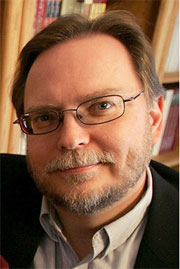 faith to others, we should take note! “The Handbook of Catholic Apologetics: Reasoned Answers to Questions of Faith” is a fantastic resource for any and all who wish to communicate the faith more clearly. It’s also for those who desire to deepen and grow in their own understanding of Catholic faith. Mark does a great job in this interview talking about some of those teachings, as well as, addressing today’s current issues.
faith to others, we should take note! “The Handbook of Catholic Apologetics: Reasoned Answers to Questions of Faith” is a fantastic resource for any and all who wish to communicate the faith more clearly. It’s also for those who desire to deepen and grow in their own understanding of Catholic faith. Mark does a great job in this interview talking about some of those teachings, as well as, addressing today’s current issues.
[powerpress]
Tags: answers to questions, catholic, catholic apologetics, catholic podcast, catholic prayer, cathollc spirituality, faith, igantius press, mark brumley
This entry was posted on Wednesday, December 22nd, 2010 at 8:43 am
You can follow any responses to this entry through the RSS 2.0 feed.
Paul Thigpen is wonderful…he answers our questions about our faith not only from the head but also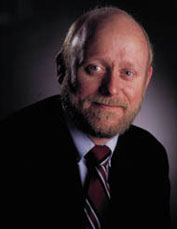 from the heart! More than just a proof text book, “Catholic Answers to Catholic Questions” tackles a why range of issues and questions.
from the heart! More than just a proof text book, “Catholic Answers to Catholic Questions” tackles a why range of issues and questions.
Catholic Answers to Catholic Questions provides solid answers to hundreds of common questions asked by people just like you questions both big and small regarding doctrine, history, morality, the pope, saints, the sacraments, the Mass, prayer, Scripture, and much more.
Be more confident in your faith. Allow the why to enhance the what you do as a Catholic. Make better decisions. Be more prepared to pass on your faith to others. Feed your curiosity. Author, theology professor, and Catholic apologist Paul Thigpen ensures the answe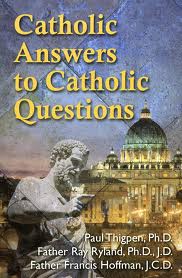 rs are not only rock-solid, but also pastoral in their approach and written in everyday, relevant language.
rs are not only rock-solid, but also pastoral in their approach and written in everyday, relevant language.
You can find this fine book here
[powerpress]
Tags: catholic, catholic answers, catholic apologist, catholic podcast, catholic prayer, cathollc spirituality, faith, morality, osv, our sunday visitor, paul thigpen, pope, sacraments, saints, scripture
This entry was posted on Friday, December 17th, 2010 at 9:07 am
You can follow any responses to this entry through the RSS 2.0 feed.
Episode 5 – Saints in Heaven – The Stones Cry Out
Roots of the Faith – From the Church Fathers to You with Mike Aquilina,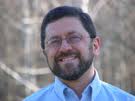 makes clear that just as an acorn grows into a tree and yet remains the same plant, so the Catholic Church is a living organism that has grown from the faith of the earliest Christians into the body of Christ we know today. Hosted by Kris McGregor
makes clear that just as an acorn grows into a tree and yet remains the same plant, so the Catholic Church is a living organism that has grown from the faith of the earliest Christians into the body of Christ we know today. Hosted by Kris McGregor
[powerpress]
Also visit Mike’s “Discerning Hearts†page for more audio downloads and information!
Tags: audio, catholic, catholic church, catholic podcast, catholic prayer, cathollc spirituality, church fathers, downloads, faith, fathers of the church, mike aquilina, saints, servant books, st. paul center for biblical theology
This entry was posted on Monday, October 25th, 2010 at 3:25 pm
You can follow any responses to this entry through the RSS 2.0 feed.
A shining example of how reason and science can lead to faith. Dr. Kevin Vost is a cradle Catholic, who fell into aethism at the age of 17. He would stay there for over 2 decades, until gradually through reasoned enlightenment (showered with God’s grace) the fallacy in aethistic philosophy was revealed and the glory of real Truth became known. Wonderful read…the journey really can be made from the head to the heart, just ask Dr. Kevin Vost!
Catholic, who fell into aethism at the age of 17. He would stay there for over 2 decades, until gradually through reasoned enlightenment (showered with God’s grace) the fallacy in aethistic philosophy was revealed and the glory of real Truth became known. Wonderful read…the journey really can be made from the head to the heart, just ask Dr. Kevin Vost!
[powerpress]
Pick up a copy of Kevin’s book
Be sure to visit Dr.  Kevin Vost’s website
Tags: aethism, catholic, catholic podcast, catholic prayer, catholicism, cathollc spirituality, Dr. Kevin Vost, faith, heart, kevin gast, Kevin Vost, osv, our sunday visitor, philosophy, psychology, science
This entry was posted on Wednesday, September 22nd, 2010 at 11:59 pm
You can follow any responses to this entry through the RSS 2.0 feed.


